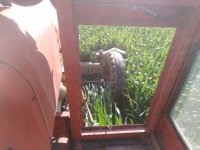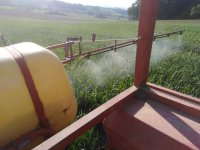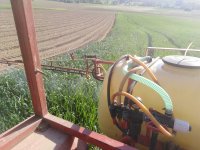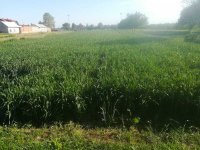Prva zastita je bila sa Falcon, a sad sam uzeo Magnello. Jel tko radio s tim magnellom? Prosaro je brutalno skup iako sam s njim radio par godina i stvarno je dobar. Mogu reci da je petrokemijas u kolicini od 150 kg po hektaru napravio dobar posao i psenica se poprilicno dobro drzi. Zdrava je i kroz par dana pusta klas.
-
Poštovani posjetitelju, za korištenje svih mogućnosti koje Poljoprivredni Forum omogućuje, predlažemo ti da se registriraš. Besplatno je i tvoja privatnost je potpuno zaštićena. Registracija ti omogućuje pristup svim kategorijama i temama, mogućnost pristupa privicima u postovima (slike, video, tutorijali, uputstva itd), pristup malom oglasniku, direktnu komunikaciju s članovima putem privatnih poruka, automatsko praćenje tema od interesa i još mnogo toga. Veselimo se tvojoj prijavi! ❤️
You are using an out of date browser. It may not display this or other websites correctly.
You should upgrade or use an alternative browser.
You should upgrade or use an alternative browser.
Pšenica 2021./2022.
- Temu pokrenuo AntonioJD
- Datum prvog posta
Antonio1996
Aktivni član
- Tu od
- 19 Pro 2020
- Poruka
- 107
Ostala mi je jedna vreča urea dali bi se mogla neka količina upotrebiti skupa sa zastitom psenice u špricanju
Propali Poljoprivrednik
Iskusan lik
- Tu od
- 25 Lip 2014
- Poruka
- 3,872
Žitarice podnose do 30% otopine UREA-e na 100L vode. Dakle jedna veća na 100L je 25% otopine UREA-e, sad ti znaš kapacitet svoje prskalice i koliko ti je to posto lako izračunaš.
Tommy
Iskusan lik
- Tu od
- 24 Sij 2021
- Poruka
- 3,614
Evo, ko zna engleski. Od prof. Svečnjaka sa Agronomskog fakulteta iz Zg. Uglavnom veli da kod pšenice koja je prije dobro prihranjena dušikom nema razlike u prinosu nego u % proteina. Kod pšenice koja je prije dobila “malo” dušika ima razlike u prinosu.
“The late-season foliar application of urea may increase yield and grain quality of wheat (Triticum aestivum L.). Limited information is available regarding the effect of late urea spraying on the performance of wheat cultivars under various basal N fertilization rates. Field experiments were conducted during 2000 through 2002 to evaluate the responses of six winter wheat cultivars to foliar urea (30 kg N ha−1) treatment around flowering at low (67 kg N ha−1) and high (194 kg N ha−1) basal N fertilization rates. Following urea spraying at low N rate, all cultivars increased grain yields to a similar extent (by an average of 7.8% or 509 kg ha−1) primarily due to an increase in the 1000-kernel weight. No yield response to the late-season urea treatment occurred at high basal N rate where grain yields averaged 24.9% (1680 kg ha−1) higher than those at low N rate. In contrast, late foliar urea application similarly improved grain quality at both low and high N rates by an average of 5 g kg−1 (4.5%) for protein content, 3.2 cm3 (11.9%) for Zeleny sedimentation, and 20 g kg−1 (8.6%) for wet gluten. These quality increments were consistent in all growing seasons regardless of significant variations in grain yields and protein concentrations across years. However, most cultivars failed to achieve breadmaking standards at low N rate as quality increments associated with the urea treatment were relatively small when compared to those achieved by high basal N rate. Late urea spraying had no effect on the falling number, whereas some cultivars showed small, but significant reduction in the gluten index at both N rates. Cultivars improved the hectolitre weight with the late-season urea treatment only at low N rate. Significant cultivar × urea interactions existed for most quality traits, which were due to the cultivar differences in the magnitude of responses. Thus, late-season urea spraying consistently produced larger yields at low basal N rate, and resulted in cultivar-dependent increases in protein content, Zeleny sedimentation, and wet gluten at both low and high N rates.”
“The late-season foliar application of urea may increase yield and grain quality of wheat (Triticum aestivum L.). Limited information is available regarding the effect of late urea spraying on the performance of wheat cultivars under various basal N fertilization rates. Field experiments were conducted during 2000 through 2002 to evaluate the responses of six winter wheat cultivars to foliar urea (30 kg N ha−1) treatment around flowering at low (67 kg N ha−1) and high (194 kg N ha−1) basal N fertilization rates. Following urea spraying at low N rate, all cultivars increased grain yields to a similar extent (by an average of 7.8% or 509 kg ha−1) primarily due to an increase in the 1000-kernel weight. No yield response to the late-season urea treatment occurred at high basal N rate where grain yields averaged 24.9% (1680 kg ha−1) higher than those at low N rate. In contrast, late foliar urea application similarly improved grain quality at both low and high N rates by an average of 5 g kg−1 (4.5%) for protein content, 3.2 cm3 (11.9%) for Zeleny sedimentation, and 20 g kg−1 (8.6%) for wet gluten. These quality increments were consistent in all growing seasons regardless of significant variations in grain yields and protein concentrations across years. However, most cultivars failed to achieve breadmaking standards at low N rate as quality increments associated with the urea treatment were relatively small when compared to those achieved by high basal N rate. Late urea spraying had no effect on the falling number, whereas some cultivars showed small, but significant reduction in the gluten index at both N rates. Cultivars improved the hectolitre weight with the late-season urea treatment only at low N rate. Significant cultivar × urea interactions existed for most quality traits, which were due to the cultivar differences in the magnitude of responses. Thus, late-season urea spraying consistently produced larger yields at low basal N rate, and resulted in cultivar-dependent increases in protein content, Zeleny sedimentation, and wet gluten at both low and high N rates.”
Propali Poljoprivrednik
Iskusan lik
- Tu od
- 25 Lip 2014
- Poruka
- 3,872
Nema se para, a vozi se Cabrio 😜😂😂




